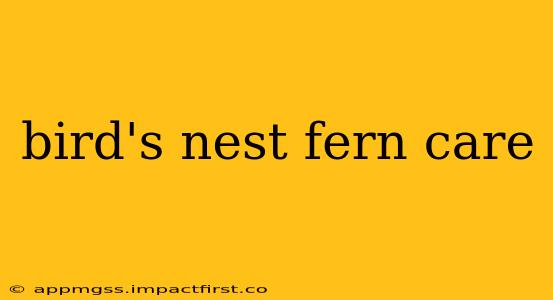Bird's nest ferns ( Asplenium nidus) are stunning, statement plants known for their striking, simple fronds. Their elegant appearance makes them a popular choice for homes and offices, adding a touch of the tropics to any space. However, their beauty comes with specific care requirements. Understanding these needs is key to cultivating a healthy, vibrant bird's nest fern that will thrive for years to come. This guide delves into everything you need to know about bird's nest fern care, from optimal light and watering techniques to common problems and solutions.
What Light Conditions Does a Bird's Nest Fern Need?
Bird's nest ferns are native to the shady understory of tropical forests. Therefore, they thrive in indirect, filtered light. Direct sunlight will scorch their delicate fronds, leaving them brown and crispy. An east- or north-facing window, or a spot several feet away from a south- or west-facing window, is ideal. Avoid placing them in completely dark locations, as this can lead to leggy growth and weakened fronds.
How Often Should I Water My Bird's Nest Fern?
Watering is crucial for bird's nest fern health. The soil should be kept consistently moist, but not soggy. Allow the top inch or two of soil to dry out slightly between waterings. Overwatering is a common problem, leading to root rot and other issues. Water thoroughly until water drains from the drainage holes, and discard any excess water in the saucer. The frequency of watering will depend on factors such as the size of the pot, the type of potting mix, and the ambient temperature and humidity. During warmer months, you may need to water more frequently.
What Type of Soil is Best for Bird's Nest Ferns?
Bird's nest ferns prefer a well-draining, airy potting mix. A mix specifically designed for epiphytes or orchids is ideal, as it provides excellent drainage and aeration. Avoid heavy, clay-based soils that retain too much moisture. You can also create a suitable mix by combining peat moss, perlite, and orchid bark.
What is the Best Humidity Level for Bird's Nest Ferns?
As tropical plants, bird's nest ferns prefer high humidity. Aim for humidity levels above 50%. In drier environments, you can increase humidity by:
- Grouping plants together: This creates a microclimate with higher humidity.
- Using a humidifier: A humidifier is a great way to maintain consistent humidity levels.
- Placing the pot on a pebble tray: Fill a tray with pebbles and water, ensuring the pot's base doesn't sit directly in the water. The evaporating water will increase humidity.
- Regular misting: While misting provides temporary humidity relief, it's not a long-term solution.
What Temperature Does a Bird's Nest Fern Prefer?
Bird's nest ferns thrive in average room temperatures, typically between 65-80°F (18-27°C). Avoid placing them near drafts, heating vents, or air conditioning units, as these can cause temperature fluctuations that stress the plant.
How Often Should I Fertilize My Bird's Nest Fern?
Fertilize your bird's nest fern once a month during the growing season (spring and summer) with a balanced, diluted liquid fertilizer. Reduce fertilization to once every six to eight weeks during the fall and winter months. Avoid over-fertilizing, as this can damage the roots.
How Do I Propagate a Bird's Nest Fern?
Bird's nest ferns are challenging to propagate at home. The most common method is through spore propagation, which is a time-consuming process best left to experienced plant propagators. Purchasing a new plant is generally a more reliable method of increasing your collection.
Why Are the Fronds of My Bird's Nest Fern Turning Brown?
Brown fronds are often a sign of overwatering, underwatering, or exposure to direct sunlight. Check the soil moisture, adjust your watering schedule, and ensure the plant isn't receiving direct sunlight. Brown tips can also indicate low humidity.
My Bird's Nest Fern is Leggy - What Should I Do?
Leggy growth usually indicates insufficient light. Move your plant to a brighter location with indirect light to encourage bushier growth.
How Often Should I Repot My Bird's Nest Fern?
Repotting is typically needed every two to three years, or when the roots become root-bound. Choose a slightly larger pot with drainage holes and use a fresh, well-draining potting mix.
By following these care guidelines, you can ensure your bird's nest fern thrives and becomes a beautiful, long-lasting addition to your indoor garden. Remember, consistent observation and attention to your plant's needs are key to its success.
